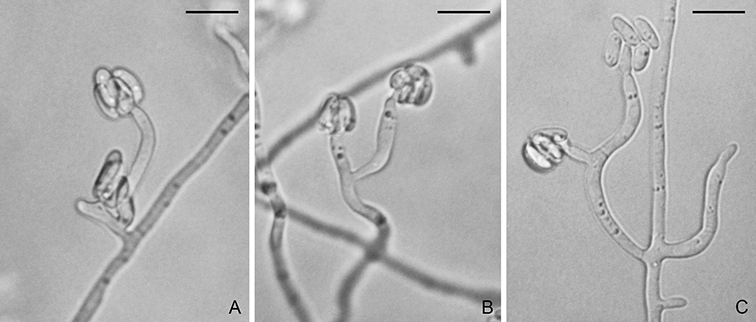
Figure. Pseudophialophora dichanthii (WSF14RG82). A–C. Conidiophores and conidia. Scale bars: A–C = 10 µm.
Pseudophialophora dichanthii J. Luo & N. Zhang.
MycoBank: MB811708.
Asexual state phialophora-like. On CMA, hyphae branched, septate, hyaline to yellowish, smooth. Conidiophores micronematous, single or branched. Conidiogenous cells phialidic, curved, hyaline to yellowish, 6–20 × 2–3.5 µm. Conidia aggregated in slimy heads, oblong ellipsoidal to ellipsoidal, straight or slightly curved, aseptate, hyaline, smooth, 4–8 × 2.5–3.5 µm. Sexual state unknown.
Colonies on PDA 2.5 cm diam after 7 days at 25 °C in dark; surface velvety, light yellow-green; aerial mycelium yellowish; reverse calliste green. Colonies on CMA 2.3 cm after 7 days at 25 °C in dark; surface light green-yellow; aerial mycelium sparse; reverse pale green-yellow (Description from Luo et al., 2015b).
Typification: Holotype RUTPPWSF14RG82. Ex-holotype culture WSF14RG82.
Gene sequences: KP769822 (18S), KP769838 (ITS), KP769830 (28S), KP784813 (MCM7), KP784821 (RPB1), KP784829 (TEF1).
Specimens examined: USA, New Jersey, Wharton State Forest, N 39 46.136, W 074 40.885, alt. 40 m, from roots of Dichanthelium acuminatum, 26 Jun. 2014, J. Luo and N. Zhang, WSF14RG12, WSF14RG41, WSF14RG70, WSF14RG72, WSF14RG82 (RUTPPWSF14RG82).
Hosts/substrates: From roots of Dichanthelium acuminatum (Poaceae).
Distribution: USA (New Jersey).
Copyright 2022 by The American Phytopathological Society. Reproduced, by permission, from Luo, J., and Zhang, N. 2022. The Rice Blast Fungus and Allied Species: A Monograph of the Fungal Order Magnaporthales (https://my.apsnet.org/APSStore/Product-Detail.aspx?WebsiteKey=2661527A-8D44-496C-A730-8CFEB6239BE7&iProductCode=46826). American Phytopathological Society, St. Paul, MN.